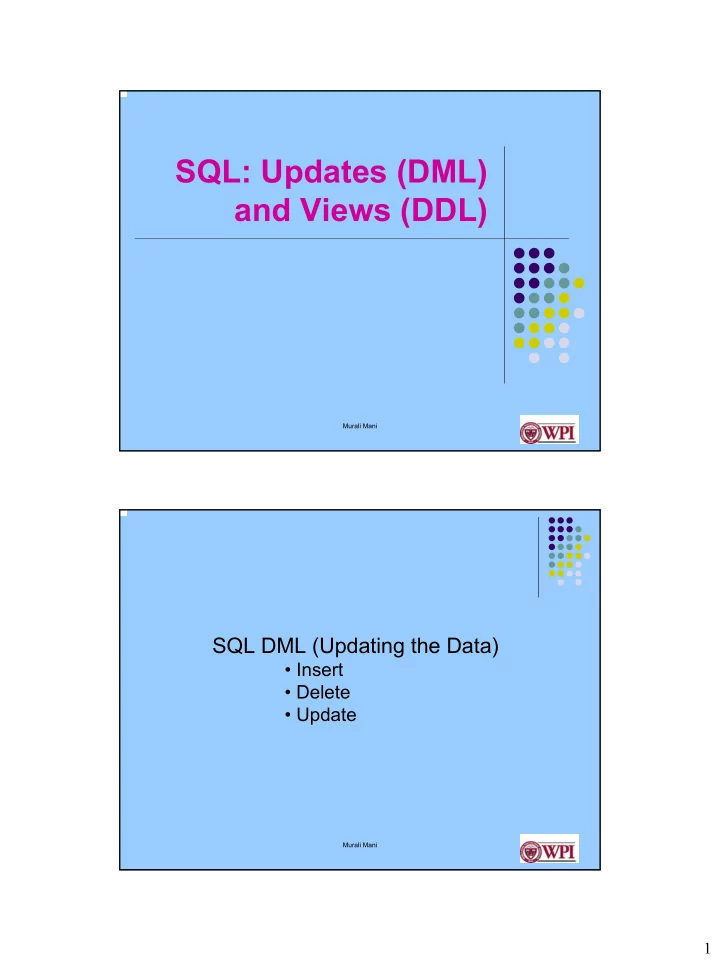

SQL: Updates (DML) and Views (DDL) Murali Mani SQL DML (Updating the Data) • Insert • Delete • Update Murali Mani 1
Inserting tuples INSERT INTO Student VALUES (6, ‘Emily’, ‘324 FL’, NULL); INSERT INTO Student (sNumber, sName) VALUES (6, ‘Emily’); INSERT INTO Professor (pNumber) SELECT professor FROM Student; Murali Mani Delete and Update � Deleting tuples DELETE FROM Student WHERE sNumber=‘6’; � Updating tuples UPDATE Student SET professor=‘ER’ WHERE sNumer=‘6’ Murali Mani 2
Views NOTE: You can present logical subsets or combinations of the data by creating views of tables. A view is a virtual table based on a table or another view. A view contains no data of its own but is like a window through which data from tables can be viewed or changed. The tables on which a view is based are called base tables. The view is stored as a SELECT statement in the data dictionary. Murali Mani Views � View is a virtual relation � Convenience: Queries on base relations might be “complex” � Logical Data Independence: “base tables” may change, but still queries using views need not change. � Provide different views of the same data. � Security: Expose only necessary data to users � Views can be queried like any “base” relation. Murali Mani 3
Views � CREATE VIEW <viewName> as <query> � DROP VIEW <viewName> CREATE VIEW studentProfessor (student, professor) AS SELECT sName, pName FROM Student, Professor WHERE Student.professor = Professor.pNumber; DROP VIEW studentProfessor Murali Mani Views - Example Student Professor sNumber sName address professor pNumber pName address 1 Dave 320FL 1 1 MM 235FL 2 Greg 320FL 1 2 ER 241FL 3 Matt 320FL 2 CREATE VIEW studentProfessor student professor (student, professor) AS SELECT sName, pName Dave MM FROM Student, Professor WHERE Student.professor = Greg MM Professor.pNumber; Matt ER SELECT * from studentProfessor Murali Mani 4
Updating Views � Consider views defined with only one relation in the FROM clause such as: CREATE VIEW MyStudent (num, name) AS SELECT sNumber, sName FROM Student; These views are updatable. Updating these views are done by updating the underlying Student tables. Murali Mani Updating Single relation Views For instance, the following updates are valid: DELETE FROM MyStudent WHERE name=`Dave'; -- This will delete the corresponding row from the Student table INSERT INTO MyStudent VALUES (4, `Mary’); -- This will be translated to INSERT INTO Student(sNumber, sName) VALUES (4, `Mary’); Murali Mani 5
Inserting into single relation views Consider the view CREATE VIEW MyStudent1(name) AS SELECT sName FROM Student; -- INSERT INTO MyStudent1 VALUES (‘Mary’) will be translated to INSERT INTO Student(sName) VALUES (‘Mary’). This will return an error as sNumber must not be null Murali Mani Updating Single relation views � If the SELECT clause specifies DISTINCT, then the view is not updatable. For instance, the following view is not updatable. CREATE VIEW MyStudent2(num) AS SELECT DISTINCT sNumber FROM Student; Murali Mani 6
Updating Single Relation Views � Note that the WHERE clause may specify subqueries. Let us consider an extreme example. CREATE VIEW MyStudent3 (num, name) AS SELECT sNumber, sName FROM Student WHERE sNumber NOT IN (SELECT sNumber FROM Student); -- this view will always have 0 tuples. Insert into this view will still insert into student table, though that tuple does not appear in the view. Murali Mani Multiple relation views: Delete Consider a multi-relation view such as CREATE VIEW studentProf(student, professor) AS SELECT sName, pName FROM Student, Professor WHERE professor=pNumber; -- Note that the pNumber is key for professor. We see that sNumber is a key for Student and also for the view (though sNumber does not appear in the result). So deleting from the views are possible by deleting appropriate sNumbers from the Student table. Murali Mani 7
Deleting from multi-relation views Try the following update statements: DELETE FROM Studentprof WHERE professor='MM'; -- This will actually delete the two rows in the student table. -- Therefore deletes can be done against multi- relation views if there is a table such that the view and the table have the same key. Murali Mani Deleting from multirelation views � Suppose we drop the key constraint on the professor table for the same view. � Now delete will fail because there is no table whose key is the key of the view. Murali Mani 8
Inserting into multi-relation views Consider the following slightly modified view definition CREATE VIEW studentProf(student, professor) AS SELECT sNumber, pName FROM Student, Professor WHERE professor=pNumber; INSERT INTO Studentprof VALUES (4, 'ER'); -- THIS ABOVE INSERT WILL FAIL AS IT TRIES TO INSERT INTO Professor TABLE AS WELL. INSERT INTO Studentprof(student) VALUES (4); -- THIS ABOVE INSERT WILL SUCCEED. Murali Mani Inserting into multi-relation views � Insert will succeed only if � The insert translates to insert into only one table. � The key for the table to be inserted will also be a key for the view. Murali Mani 9
Recommend
More recommend